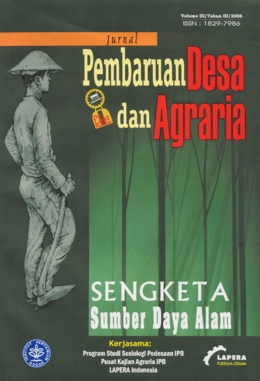Laporan/Prosiding

Sanitation and Hygiene in Kenya : Lessons on What Drives Demand for Improved Sanitation
WSP
15 September 2004
969

Jurnal Pembaruan Desa dan Agraria "Sengketa Sumber Daya Alam" Volume III/Tahun III/2006
2006
1.864

Perkembangan Ekonomi Kota - kota Sebelum dan Pasca Krisis 1993 - 1999 serta implikasi pengembangannya.(Paper Series No. 3)
Bambang Tata Samiadji
Februari Th.2
1.120

Profil gender di kabupaten Cirebon, Ciamis, dan Bogor sasaran proyek WSLIC-2 propinsi jawa barat, th. 2004
Yayasan Alturist Bandung
Th.
1.140

Catatan Diskusi Terfokus Kebijakan Nasional Air Bersih Dan Penyehatan Lingkungan yang Berkelanjutan Di Sumba Timur
Maret Th.2
1.090
Tujuan Diskusi Kebijakan Air Bersih Dan Penyehatan Lingkungan adalah untuk menyamakan persepsi kepada seluruh peserta tentang program ABPL yang berkelanjutan, membantu peserta untuk memahami prinsip - prinsip kebijakan nasional pembangunan ABPL, menggali masukan dan harapan pesrta terhadap ProAir dalam menerapkan prinsip kebijakan nasional dalam melaksanakan programnya serta menggali masukan dukungan apa yang akan diberikan kepada ProAir dalam melaksanakan progamnya.
Pertemuan dilaksanakan selama 9 jam efektif dibagi selama 2 hari. Pada hari pertama diskusi kearah pemahaman tentang Waspola, pokok-pokok kebijakan Nasional ABPL, konsep kesinambungan program ABPL, masukan-masukan Pemda terhadap ProAir dalam penerapan prinsip kebijakan nasional dalam pembangunan AMPL. Pada hari kedua diskusi dilaksanakan dalam rangka mempertajam dan klarifikasi terhadap hasil diskusi hari pertama.
Pertemuan ini menghasilkan pemahaman peserta tentang prinsip-prinsip kebijakan nasional ABPL, koreksi dari ketua Bappeda Sumba Timur terhadap beberapa bagian dari kebijakan Pemda Sumba Timur selama ini, harapan dan masukan untuk Pro Air untuk mempertemukan dan mengatasi ketidaksepahaman selama ini, serta rencana pertemuan penyamaan persepsi dengan ProAir Bappeda di luar Sumba Timur untuk menghindari ketidaknetralan salah satu pihak.


Management of Solid Health - Care Waste at Primary Health - Care Centres: A Decision Making Guide
Th.
1.130
The objectives of this document is to provide guidence for selecting the most appropriate for safety managing solid waste generated at primary health centres in developing countries. The main tool of this guide consists of six decision-trees aimed at assiting the user in identifying appropriate waste management methods. The guide takes into consideration the most relevant local conditions, the safety of workers and of the general public as well as to environmental criteria. This guide is composed following parts: i. basic risks assiciated with poor management of healthcaere waste. ii. basic elements for safe health-care waste management(HCWM). iii, parameters to assess before selecting HCWM. iv. technical annexes describing HCWM options. v. estimation of cost of the various options. This guide may also be used to evaluate existing practices related to health-care waster management. More detailed sources of information on handling and storage practices, tecnical options for treatment and disposal of wates, training and personal pratection, and assessment of a countrys situation, are presented in annex A.

Good Dams and Bad Dams: Environmental Criteria for Site Selection of Hydroelectric Projects (Latin America and Caribbean Region Sustainable Development Working Paper 16)
George Ledec & Juan David Quintero
Th.
1.390
This paper provides a simple, yet robust, methodology for comparing proposed hydroelectric project sites in terms of their expected negative environmental impacts, and relating these ti power generation benefit. The paper also summarised the environmental mitigation options for large dams. If properly implemented, these mitigation measures can effectively prevent, minimize, or compensate for many (though not all) of a hydroelectric projects negative impacts. Nonetheles, the most effective environmental mitigation measure is good site selection, to ensure that the proposed dam will couse relatively little damage in the firs place.
The paper present quantitative indicators (using data that are relatively easy to obtain) for rating and ranking proposed new hydroeletric project in trems of their likely adverse environmental impacts.Project with a small reservoir survace area tend to be most desirable from both an environmental and social standpoint, in part because they minimize natural habitat losses as well as resettlement needs, In general, the most environmentally benign hydroelectric dam sites are on upper tributaries, while the most problematic ones are on the large main stems of rivers.

